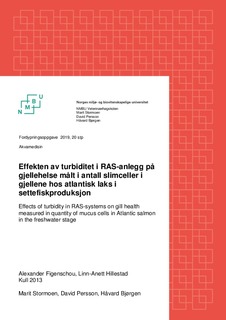| dc.description.abstract | I dette studiet ble det studert sammenhengen mellom turbiditet og antall slimceller i gjellene til atlantisk laks. Hypotesen var at høy turbiditet (og dermed lav siktdybde i vannkarene) i RAS-anlegg kan føre til økt mekanisk belastning på gjellene. Denne belastningen kan tenkes å gi en økning i antall slimceller. Gjeller fra totalt 220 fisk fra fem ulike resirkuleringsanlegg ble samlet inn. 20 fisk ble prøvetatt fra hvert anlegg med to ukers mellomrom (totalt 40 fisk fra hvert anlegg). En fiskegruppe fra et tradisjonelt gjennomstrømningsanlegg (n=20) ble også inkludert i studiet.
Resultatene viste en ikke-signifikant sammenheng mellom antall slimceller i gjellene og siktdybde i karene. Derimot ble det funnet sammenheng mellom slimcelletall i gjellene og hvilken lokalitet fisken kom fra. Lavest slimcelletall var det i gjennomstrømningsanlegget.
Det ble utviklet en standardisert metode for å telle slimceller i gjellene hos atlantisk laks. Av variablene dette studiet tok for seg var det anlegg og vekt som signifikant påvirket antall slimceller. Årsaken til den signifikante forskjellen i antall slimceller mellom de ulike anleggene skyldes trolig sammensatte faktorer som ulike driftsrutiner, ulik teknisk innredning og vannkvalitetsparametere, som alle er viktige parametere som påvirker gjellehelsen.
Gjellehelse i RAS-anlegg ble i fiskehelserapporten 2018 definert som et problemområde. I dette studiet ble det kun registrert ett individ med nevneverdige patologiske forandringer (betennelse og hyperplasi av sekundærlamellene), blant et relativt stort utvalg materiale. Dette i seg selv er et interessant funn, selv om anleggene ikke var valgt tilfeldig. Det ble derimot påvist en signifikant sammenheng mellom lavere slimcelleantall og fisk fra gjennomstrømningsanlegg sett opp mot RAS-anleggene. Utvalget fra gjennomstrømningsanlegget var mindre enn i RAS-anleggene, som gir mindre styrke til dette resultatet og det kan derfor ikke trekkes noen faste konklusjoner angående gjellhelse i gjennomstrømningsanlegg i forhold til RAS-anlegg.
Resultatene viser til en forskjell i antall slimceller mellom anleggene og vekt på fisken. Videre studier trengs for å avklare om mengden slimceller kan brukes til å fortelle noe om gjellehelsen til fisk.
The aim of this study was to examine if there is a statistical correlation between turbidity and the number of mucus cells in the gills of Atlantic salmon. The main hypothesis was that high turbidity (measured in a low Secchi depth in the fishtanks) in RAS-farms can lead to an increase in mechanical load on the gills. This increase in load could be thought to lead to a response in the form of an increase in the number of mucus cells in the gills. Gill samples from a total of 220 fish from five different RAS farms were collected. 20 fish were sampled from each RAS farm with a two-week interval (a total of 40 fish from each RAS farm).
A group of fish from a traditional flow-through farm (n=20) was also included in this study. The results of this study showed a non-significant relationship between the number of mucus cells and the Secchi depth. However, there was a relationship between the number of mucus cells and which farm the fish originated from. The lowest mucus cells numbers were found in the flow-through farm. The reason for this relationship is probably complex and dependent upon a large number of variables concerning management and water quality. There was also found a significant correlation between the number of mucus cells and the weight of the fish.
This study also developed and tested a new standardized method/protocol for counting the number of mucus cells in the gills of Atlantic salmon. Gill health in RAS farms was in the Norwegian fish health report of 2018 defined as an area of concern. In this study, however, there was only registered one individual, out of a reasonably large group, with notable pathological findings (inflammation and hyperplasia of the secondary lamella).
This is in its self an interesting observation, even though the locations were not randomly selected. There was, however, a significant relationship between a lower number of mucus cells and the fish from the flow-through farm, seen in contrast with RAS farms. The sample size from the flow-through farm was, however, smaller, which weakens the strength of this finding. We are therefore not able to draw any tangible conclusions and further studies on the matter are warranted.
The results of this study suggest that the number of mucus cells in the gills possibly could be used as an indicator of gill health in fish in RAS farms, however, not solely dependent on the clarity of the water, but of the basis of location and weight. | nb_NO |

